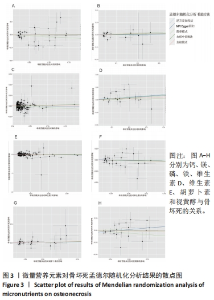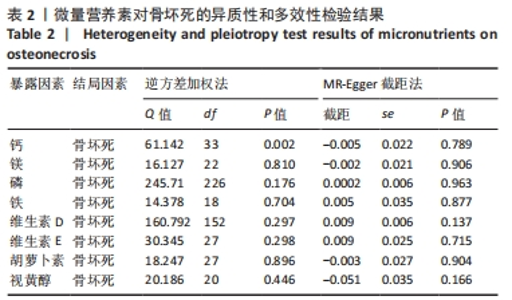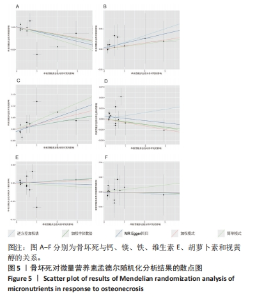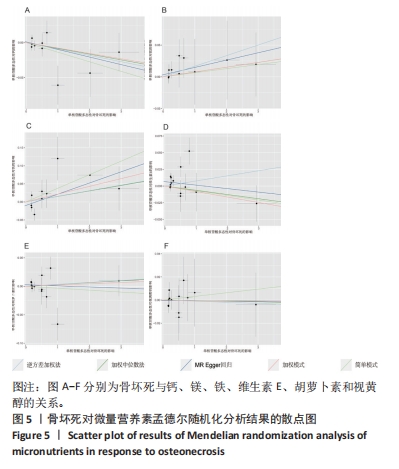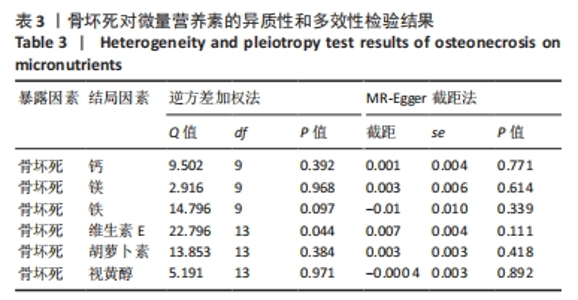Chinese Journal of Tissue Engineering Research ›› 2024, Vol. 28 ›› Issue (33): 5308-5314.doi: 10.12307/2024.686
Previous Articles Next Articles
Causal association of micronutrients with osteonecrosis: evidence from a bidirectional Mendelian randomization trial
Li Wei1, Chai Jinlian2, Jia Haifeng3, Li Hanzheng3, Sun Tiefeng4, Liang Xuezhen3
- 1College of Traditional Chinese Medicine, 2College of Pharmacy, 3First College of Clinical Medicine, Shandong University of Traditional Chinese Medicine, Jinan 250355, Shandong Province, China; 4Shandong Provincial Research Institute of Traditional Chinese Medicine, Jinan 250014, Shandong Province, China
-
Received:2023-10-17Accepted:2023-11-25Online:2024-11-28Published:2024-01-30 -
Contact:Liang Xuezhen, MD, Associate professor, Master’s supervisor, First College of Clinical Medicine, Shandong University of Traditional Chinese Medicine, Jinan 250355, Shandong Province, China -
About author:Li Wei, College of Traditional Chinese Medicine, Shandong University of Traditional Chinese Medicine, Jinan 250355, Shandong Province, China -
Supported by:National Natural Science Foundation of China, No. 82205154 (to LXZ); Youth Project of Natural Science Foundation of Shandong Province, No. ZR2021QH004 (to LXZ); Shandong Medical and Health Science and Technology Development Plan Project, No. 2019WS577 (to LXZ); Chinese Medicine Science and Technology Project of Shandong Province, No. 2020Q009 (to LXZ); Jinan Clinical Medical Science and Technology Innovation Plan, No. 202019056 (to LXZ)
CLC Number:
Cite this article
Li Wei, Chai Jinlian, Jia Haifeng, Li Hanzheng, Sun Tiefeng, Liang Xuezhen. Causal association of micronutrients with osteonecrosis: evidence from a bidirectional Mendelian randomization trial[J]. Chinese Journal of Tissue Engineering Research, 2024, 28(33): 5308-5314.
share this article
Add to citation manager EndNote|Reference Manager|ProCite|BibTeX|RefWorks
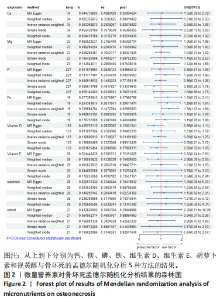
2.1 工具变量 首先在探究微量营养素对骨坏死的因果关系时,根据工具变量筛选原则,提取与钙、镁、磷、铁、维生素D、维生素E、胡萝卜素和视黄醇强相关SNP在结局中的信息时分别丢失了3,0,5,0,3,2,0,1个SNP。剔除回文序列后最终得到了34,23,227,19,153,28,28,21个工具变量,其中利用PhenoScanner数据库检索有关的表型,剔除其对应表型与骨坏死具有相关意义的2个SNP(rs1800562,rs116337889)。在探究骨坏死对微量营养素的因果关系时,提取与骨坏死强相关SNP在钙、镁、磷、铁、维生素D、维生素E、胡萝卜素和视黄醇中的信息时分别丢失了9,9,17,9,17,1,1,1个SNP。剔除回文序列后,最终结局为钙、镁、铁、维生素E、胡萝卜素和视黄醇时分别获取了10,10,10,14,14,14个工具变量,磷和维生素D在剔除回文序列后没有足够的SNP进行后续的MR分析。所有SNP均符合工具变量筛选标准。 2.2 微量营养素对骨坏死疾病的影响 逆方差加权法分析结果显示,基因预测的钙与骨坏死(OR=0.939,95%CI:0.53-1.664,P=0.828)、镁与骨坏死(OR=1.029,95%CI:0.744-1.422,P=0.864)、磷与骨坏死(OR=0.960,95%CI:0.730-1.263,P=0.772)、维生素D与骨坏死(OR=0.894,95%CI:0.638-1.251,P=0.512)、维生素E与骨坏死(OR=1.005,95%CI:0.575-1.760,P=0.984)、胡萝卜素与骨坏死(OR=1.151,95%CI:0.658-2.011,P=0.622)、视黄醇与骨坏死(OR=0.846,95%CI:0.432-1.656,P=0.626)之间无统计学意义,所以不存在因果关系。而基因预测的铁与骨坏死(OR=1.377,95%CI:1.032-1.837,P=0.030)表明血清铁浓度是骨坏死的危险因素且具有统计学意义,同时应用其他4种分析方法来确认结果的稳健性,其中,该4种方法的分析结果虽无统计学意义,但和逆方差加权法方法分析的方向一致(OR值均> 1),见图2,3。"

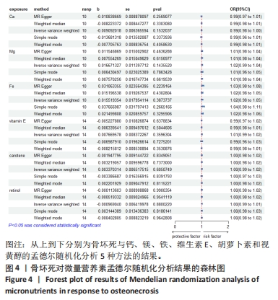
.4 骨坏死疾病对微量营养素的影响 逆方差加权法分析结果显示,基因预测的骨坏死与钙(OR=0.991,95%CI:0.979-1.003,P=0.153)、骨坏死与镁(OR=1.017,95%CI:0.994-1.040,P=0.144)、骨坏死与铁(OR=1.016,95%CI:0.981-1.052,P=0.387)、骨坏死与维生素E(OR=1.008,95%CI:0.991-1.024,P=0.360)、骨坏死与胡萝卜素(OR=1.003,95%CI:0.991-1.016,P=0.605)、骨坏死与视黄醇(OR=0.999,95%CI:0.987-1.012,P=0.880)之间无统计学意义,所以不存在反向因果关系,见图4,5。"

| [1] WEINSTEIN RS. Glucocorticoid-induced osteonecrosis. Endocrine. 2012; 41(2):183-190. [2] HERNIGOU P. Hip osteonecrosis. Rev Prat. 2020;70(4):409-415. [3] PAVELKA K. Osteonecrosis. Baillieres Best Pract Res Clin Rheumatol. 2000;14(2):399-414. [4] ZHAO D, ZHANG F, WANG B, et al. Guidelines for clinical diagnosis and treatment of osteonecrosis of th e femoral head in adults (2019 version). J Orthop Translat. 2020;21:100-110. [5] KELMAN GJ, WILLIAMS GW, COLWELL CW JR, et al. Steroid-related osteonecrosis of the knee. Two case reports and a lite rature review. Clin Orthop Relat Res. 1990;(257):171-176. [6] LONERGAN GJ, CLINE DB, ABBONDANZO SL. Sickle cell anemia. Radiographics. 2001;21(4):971-994. [7] JONES JP JR. Fat embolism and osteonecrosis. Orthop Clin North Am. 1985;16(4):595-633. [8] WANG X, CHEN X, LU L, et al. Alcoholism and Osteoimmunology. Curr Med Chem. 2021;28(9):1815-1828. [9] KANEKO K, CHEN H, KAUFMAN M, et al. Glucocorticoid-induced osteonecrosis in systemic lupus erythematosus patients. Clin Transl Med. 2021;11(10):e526. [10] LESPASIO MJ, SODHI N, MONT MA. Osteonecrosis of the Hip: A Primer. Perm J. 2019:23:18-100. [11] WATANABE S, NAKAJIMA K, MIZOKAMI A, et al. Bone scan index of the jaw: a new approach for evaluating early-stage anti-resorptive agents-related osteonecrosis. Ann Nucl Med. 2017;31(3):201-210. [12] BLUEMKE DA, ZERHOUNI EA. MRI of avascular necrosis of bone. Top Magn Reson Imaging. 1996;8(4):231-246. [13] FU W, LIU B, WANG B, et al. Early diagnosis and treatment of steroid-induced osteonecrosis of the femoral head. Int Orthop. 2019;43(5): 1083-1087. [14] WELLS ME, DUNN JC. Pathophysiology of Avascular Necrosis. Hand Clin. 2022;38(4):367-376. [15] ESCUDIER JC, OLLIVIER M, DONNEZ M, et al. Superimposition of maximal stress and necrosis areas at the top of the femoral head in hip aseptic osteonecrosis. Orthop Traumatol Surg Res. 2018;104(3): 353-358. [16] WING PC, NANCE P, CONNELL DG, et al. Risk of avascular necrosis following short term megadose methylprednis olone treatment. Spinal Cord. 1998;36(9):633-636. [17] WANG XS, ZHUANG QY, WENG XS, et al. Etiological and clinical analysis of osteonecrosis of the femoral head in Chinese patients. Chin Med J. 2013;126(2):290-295. [18] CHEN H, XU J, LV Y, et al. Proanthocyanidins exert a neuroprotective effect via ROS/JNK signaling in MPTP‑induced Parkinson’s disease models in vitro and in vivo. Mol Med Rep. 2018;18(6):4913-4921. [19] DELLA-MORTE D, PACIFICI F. Nature can still be the strongest help against aging and neurodegeneration: the sirtuins way. Neural Regen Res. 2023;18(6):1271-1272. [20] DE BASTIANI G, BOSELLO O, MAGNAN B, et al. Metabolic and nutritional factors in the pathogenesis of idiopathic os teonecrosis of the head of the femur (preliminary results of a long-te rm follow-up investigation). Ital J Orthop Traumatol. 1984;10(1):85-93. [21] CAPOZZI A, SCAMBIA G, LELLO S. Calcium, vitamin D, vitamin K2, and magnesium supplementation and skeletal health. Maturitas. 2020; 140:55-63. [22] KURIBAYASHI M, FUJIOKA M, TAKAHASHI KA, et al. Vitamin E prevents steroid-induced osteonecrosis in rabbits. Acta Orthopaedica. 2010; 81(1):154-160. [23] FISCHER V, HAFFNER-LUNTZER M, AMLING M, et al. Calcium and vitamin D in bone fracture healing and post-traumatic bone turnover. Eur Cell Mater. 2018;35:365-385. [24] YEE MMF, CHIN KY, IMA-NIRWANA S, et al. Vitamin A and Bone Health: A Review on Current Evidence. Molecules. 2021;26(6):1757. [25] 张琳, 汪轩, 张成龙, 等.激素性股骨头坏死大鼠模型股骨钙、磷、镁、锌元素含量变化的研究[J].中华中医药杂志,2017,32(1):317-320. [26] BURT LA, BILLINGTON EO, ROSE MS, et al. Effect of High-Dose Vitamin D Supplementation on Volumetric Bone Densi ty and Bone Strength: A Randomized Clinical Trial. JAMA. 2019;322(8):736-745. [27] VERMEER C, JIE KS, KNAPEN MH. Role of vitamin K in bone metabolism. Annu Rev Nutr. 2019;15:1-22. [28] BIRNEY E. Mendelian Randomization. Cold Spring Harb Perspect Med. 2022;12(4):a041302. [29] SEKULA P, DEL GRECO MF, PATTARO C, et al. Mendelian Randomization as an Approach to Assess Causality Using Obser vational Data. J Am Soc Nephrol. 2016;27(11):3253-3265. [30] EVANS DM, DAVEY SMITH G. Mendelian Randomization: New Applications in the Coming Age of Hypothe sis-Free Causality. Annu Rev Genomics Hum Genet. 2015;16:327-350. [31] SKRIVANKOVA VW, RICHMOND RC, WOOLF BAR, et al. Strengthening the Reporting of Observational Studies in Epidemiology U sing Mendelian Randomization: The STROBE-MR Statement. JAMA. 2021; 326(16):1614-1621. [32] EMDIN CA, KHERA AV, KATHIRESAN S. Mendelian Randomization. JAMA. 2017;318(19):1925-1926. [33] LI P, WANG H, GUO L, et al. Association between gut microbiota and preeclampsia-eclampsia: a two-s ample Mendelian randomization study. BMC Med. 2022;20(1):443. [34] XIAO G, HE Q, LIU L, et al. Causality of genetically determined metabolites on anxiety disorders: a two-sample Mendelian randomization study. J Trans Med. 2022;20(1):475. [35] STAIGER DO, STOCK JH. Instrumental variables regression with weak instruments. National Bureau of Economic Research Cambridge, Mass., USA. 1994. [36] MANOUSAKI D, HARROUD A, MITCHELL RE, et al. Vitamin D levels and risk of type 1 diabetes: A Mendelian randomizatio n study. PLoS Med. 2021;18(2):e1003536. [37] HEMANI G, TILLING K, DAVEY SMITH G. Orienting the causal relationship between imprecisely measured traits using GWAS summary data. PLoS Genet. 2017;13(11):e1007081. [38] MUTIJIMA E, DE MAERTELAER V, DEPREZ M, et al. The apoptosis of osteoblasts and osteocytes in femoral head osteonecro sis: its specificity and its distribution. Clin Rheumatol. 2014;33(12):1791-1795. [39] DIXON SJ, LEMBERG KM, LAMPRECHT MR, et al. Ferroptosis: an iron-dependent form of nonapoptotic cell death. Cell. 2012;149(5):1060-1072. [40] LO ACY, YANG M. Lycium barbarum polysaccharides and ferroptosis: jumping into the era of novel regulated cell death. Neural Regen Res. 2022;17(7):1473-1474. [41] LI J, HOU Y, ZHANG S, et al. Excess iron undermined bone load-bearing capacity through tumor necros is factor-α-dependent osteoclastic activation in mice. Biomed Rep. 2013;1(1):85-88. [42] ZARJOU A, JENEY V, AROSIO P, et al. Ferritin ferroxidase activity: a potent inhibitor of osteogenesis. Journal of bone and mineral research: the official journal of the Ame rican Soc Bone Miner Res. 2010;25(1): 164-172. [43] HOU JM, XUE Y, LIN QM. Bovine lactoferrin improves bone mass and microstructure in ovariectom ized rats via OPG/RANKL/RANK pathway. Acta Pharmacol Sin. 2012;33(10):1277-1284. [44] CORNISH J, CALLON KE, NAOT D, et al. Lactoferrin is a potent regulator of bone cell activity and increases bone formation in vivo. Endocrinology. 2004;145(9):4366-4374. [45] YANG Q, JIAN J, ABRAMSON SB, et al. Inhibitory effects of iron on bone morphogenetic protein 2-induced ost eoblastogenesis. J Bone Miner Res. 2011;26(6):1188-1196. [46] KERACHIAN MA, SÉGUIN C, HARVEY EJ. Glucocorticoids in osteonecrosis of the femoral head: a new understand ing of the mechanisms of action. J Steroid Biochem Mol Biol. 2009;114(3-5): 121-128. [47] MIKAMI T, ICHISEKI T, KANEUJI A, et al. Prevention of steroid-induced osteonecrosis by intravenous administration of vitamin E in a rabbit model. J Orthop Sci. 2010;15(5):674-677. [48] 黎牧帆, 张二洋, 吕雷锋, 等.维生素E对大鼠早期激素性股骨头缺血性坏死的作用及机制研究[J].中国修复重建外科杂志,2018, 32(11):1421-1428. [49] KNIGHT A. Systematic reviews of animal experiments demonstrate poor human clinic al and toxicological utility. Altern Lab Anim. 2007; 35(6):641-659. [50] BAILOO JD, REICHLIN TS, WÜRBEL H. Refinement of experimental design and conduct in laboratory animal res earch. ILAR J. 2014;55(3): 383-391. [51] 张海荣, 王赋敏, 王连才, 等.血清骨钙素、碱性磷酸酶、钙、磷、铁蛋白浓度与潜水员减压性骨坏死的关系——附128例分析[J].海军医学,1993(4):291-293. [52] 裴凌鹏, 董福慧, 惠伯棣, 等.β,β-胡萝卜素改善H2O2对成骨细胞损伤的影响[J].西安交通大学学报(医学版),2007(1):78-82. [53] VU AA, KUSHRAM P, BOSE S. Effects of Vitamin A (Retinol) Release from Calcium Phosphate Matrices and Porous 3D Printed Scaffolds on Bone Cell Proliferation and Matura tion. ACS Appl Bio Mater. 2022; 5(3): 1120-1129. [54] KHAZAI N, JUDD SE, TANGPRICHA V. Calcium and vitamin D: skeletal and extraskeletal health. Curr Rheumatol Rep. 2008;10(2): 110-117. [55] LEIDI M, DELLERA F, MARIOTTI M, et al. High magnesium inhibits human osteoblast differentiation in vitro. Magnes Res. 2011;24(1):1-6. |
| [1] | Chen Kaijia, Liu Jingyun, Cao Ning, Sun Jianbo, Zhou Yan, Mei Jianguo, Ren Qiang. Application and prospect of tissue engineering in treatment of osteonecrosis of the femoral head [J]. Chinese Journal of Tissue Engineering Research, 2024, 28(9): 1450-1456. |
| [2] | Shen Jiangyong, He Xi, Tang Yuting, Wang Jianjun, Liu Jinyi, Chen Yuanyuan, Wang Xinyi, Liu Tong, Sun Haoyuan. RAS-selective lethal small molecule 3 inhibits the fibrosis of pathological scar fibroblasts [J]. Chinese Journal of Tissue Engineering Research, 2024, 28(8): 1168-1173. |
| [3] | Zhao Rushun, Hao Yangquan, Xu Peng, Zheng Xin, Jiang Yonghong, Zhang Yuting, Wang Mengfei, Lu Chao. Effect of different locations of necrotic focus on the natural course of non-traumatic osteonecrosis of the femoral head [J]. Chinese Journal of Tissue Engineering Research, 2024, 28(6): 917-921. |
| [4] | Hu Zhixing, Li Qun, Yang Chao, Wang Xiaoxiao, Fang Luochangting, Hou Wuqiong, Lin Na, Chen Weiheng, Liu Chunfang, Lin Ya. Network meta-analysis of the modeling effects of different factors on rabbit models of steroid-induced osteonecrosis of femoral head [J]. Chinese Journal of Tissue Engineering Research, 2024, 28(6): 976-984. |
| [5] | Zhang Yaru, Chen Yanjun, Zhang Xiaodong, Chen Shenghua, Huang Wenhua. Effect of ferroptosis mediated by glutathione peroxidase 4 in the occurrence and progression of synovitis in knee osteoarthritis [J]. Chinese Journal of Tissue Engineering Research, 2024, 28(4): 550-555. |
| [6] | Liu Yi, Liu Yuan, Liu Jinbao, Li Nianhu, Zhu Weiming, Xu Bo. Causal effects of serum trace elements and nutrients on osteonecrosis: a Mendelian randomization analysis [J]. Chinese Journal of Tissue Engineering Research, 2024, 28(33): 5326-5332. |
| [7] | Chen Jixin, Yu Weijie, Guo Tianci, Zhou Qinxin, Niu Puyu, Ye Yuntian, Liu Aifeng. Sleep characteristics and risk of osteoarthritis: a two-sample and multivariate Mendelian randomization study [J]. Chinese Journal of Tissue Engineering Research, 2024, 28(32): 5203-5209. |
| [8] | Chen Guanting, Zhang Linqi, Wang Xixi, Chen Xu. Autophagy, ferroptosis-related targets and renal function progression in patients with chronic kidney disease: bioinformatics analysis and experimental verification [J]. Chinese Journal of Tissue Engineering Research, 2024, 28(32): 5122-5129. |
| [9] | Zhao Rushun, Hao Yangquan, Xu Hanbo, Yang Zhi, Xu Peng, Zheng Xin, Zhang Kun, Lu Chao. Natural collapse course of ARCO II stage osteonecrosis of the femoral head based on China-Japan Friendship Hospital classification [J]. Chinese Journal of Tissue Engineering Research, 2024, 28(30): 4871-4875. |
| [10] | Xu Wenfei, Ming Chunyu, Duan Kan, Yuan Changshen, Guo Jinrong, Hu Qi, Zeng Chao, Mei Qijie. Identification of ferroptosis signature genes in osteoarthritis based on WGCNA and machine learning and experimental validation [J]. Chinese Journal of Tissue Engineering Research, 2024, 28(30): 4909-4914. |
| [11] | Li Shudong, Liang Xuezhen, Luo Di, Li Jiacheng, Yan Bozhao, Li Gang. Identification of biomarkers associated with ferroptosis and pyroptosis for the potential diagnosis of postmenopausal osteoporosis [J]. Chinese Journal of Tissue Engineering Research, 2024, 28(28): 4511-4515. |
| [12] | Zhang Zhibin, Wang Chu, Han Ying, Wang Jia, Lyu Junqing, Lin Xuerong, Yuan Meng, Han Shuchi. Changes and biological significance of ferroptosis in a mouse model of bloodstream infection induced by different bacteria [J]. Chinese Journal of Tissue Engineering Research, 2024, 28(28): 4553-4558. |
| [13] | Chen Tianxin, Dong Tingting, Li Yan, Zhang Sheng, Zhang Lei. Causal relationship between blood metabolites and sarcopenia-related traits: a Mendelian randomization study [J]. Chinese Journal of Tissue Engineering Research, 2024, 28(27): 4288-4292. |
| [14] | Yu Peng, Meng Dongfang, Li Huiying, Zhang Xiangbei. Bioinformatics identification of CA9 as a signature gene for cartilage-associated ferroptosis in steroid-induced osteonecrosis of the femoral head [J]. Chinese Journal of Tissue Engineering Research, 2024, 28(27): 4293-4299. |
| [15] | Fan Yidong, Qin Gang, He Kaiyi, Gong Yufang, Li Weicai, Wu Guangtao. Expression of immune-related genes in rheumatoid arthritis and a two-sample Mendelian randomization study of immune cells [J]. Chinese Journal of Tissue Engineering Research, 2024, 28(27): 4312-4318. |
| Viewed | ||||||
|
Full text |
|
|||||
|
Abstract |
|
|||||
